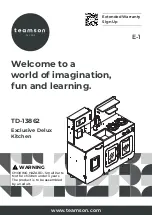
6
Identification of Controls and Fillers.
1.
Steam regulator
2. Reverse lever
3. Gas regulator
4. Lubricator filler cap
5. Boiler water filler
6. Gas tank filler valve
7. Burner air control ring
8. Pressure gauge
9. Water sight glass
10. Boiler drain valve
The Accucraft Bagnall saddle tank, Historical Notes.
Bagnall were renowned builders of industrial locomotives for both standard gauge
and narrow gauge. They developed a huge range of designs and built numerous
engines for the ‘big four’ and the MOD. The 7″ x 12″ saddle tank was a mid-range
narrow gauge design with a marine-type firebox that could be supplied in a number
of different formats - over a 100 were built in this style. Several examples of the type
have been preserved, one of the most famous being the Rev. Teddy Boston’s
Pixie
which ran round his railway in the garden of Cadeby rectory! The Accucraft model is
closely based on
Woto
, originally a 3’ 6” gauge machine delivered to Callenders
Cables Construction Company Limited of Erith, Kent in 1924 at a cost of £675. Her
prompt building time of under two months was made possible by the maker’s practice
of laying batches of the major components (cylinders, boiler, frame plates, etc) down
to stock and then finishing them to suit customer requirements upon receipt of an
order. The Callenders’ system closed in 1968 but both
Woto
and
Sir Tom
were saved
for preservation,
Woto
ultimately ending up with Alan and Patrick Keef’s engineering
business near Ross on Wye where it was converted to 2’ gauge.


























